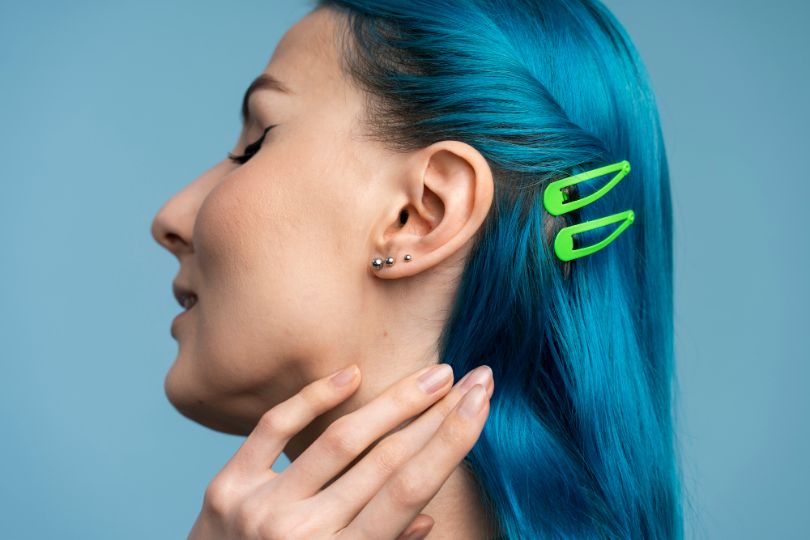As you dive into the world of earlobe piercings, the sparkle comes hand in hand with some potential pitfalls. Infections, bumps, and allergic reactions might join the party. Your choices matter, so make sure your ear-game is strong. Enjoy the ear-piercing journey but remember – every sparkle has its story. Yours should be beautiful and infection-free.
Did you know a whopping 84% of fabulous females in the USA rock a pierced earlobe? Yes, that’s true. And if you’re thinking about getting your ear pierced too, this blog is for you. But let’s keep it real – even the simplest earlobe piercing has quirks. For instance, infections might be the party crashers no one wants. No worries, though! We’ve got you covered. From gotta-know tips to easy-peasy aftercare tricks, you’ll read everything here.
Medical Conditions That Can Affect Your Ear Piercing
Here are some medical conditions to consider when making ear-piercing plans.
Diabetes
Diabetes isn’t sweet when it comes to ear piercings. High blood sugar levels can mess with your body’s ability to heal wounds. Your new piercing needs a smooth healing process. So, diabetes might just hit the pause button on that. The Journal of Diabetes Science and Technology highlights the potential complications. As per the journal, delayed wound healing is among the major complications. Along with it, there’s a high risk of getting an infection.
Blood Clotting Disorders
Clotting is not great when it comes to fresh piercings. The ear-piercing healing time might be slower if you’ve got a blood clotting disorder. It’s like putting a speed bump on your road to fabulous ear bling. For instance, if you’ve got hemophilia, think before piercing those ears. The National Hemophilia Foundation warns that piercing can lead to prolonged bleeding and complications. The lack of clotting factor in your blood might turn a simple piercing into a medical emergency. So, before you make any decision, consult with your healthcare provider.
Autoimmune Disorders
Your immune system is like a superhero, but it can be too active. Conditions like lupus or rheumatoid arthritis may cause it to act up. Eventually, it can cause inflammation and issues for your newly pierced ears. Your immune system needs to chill, but with these conditions, it’s on high alert. As per the Cleveland Clinic, exercise caution before ear piercing if you’ve got lupus. It is because the nuances may hinder the healing process.
Allergies
Did you know you could be allergic to certain metals? Nickel allergies are quite common. So, if your piercing equipment contains this metal, it could lead to redness. Along with it, you’ll feel itchiness and all-around discomfort. According to the American Academy of Allergy, Asthma & Immunology, allergic reactions can flare up with foreign substances. In such situations, always consider talking to your allergist.
Keloid Scarring Tendency
Ever had a small cut turn into a big, gnarly scar? If you’re prone to keloid scarring, getting an ear piercing might not be the best. It feels like playing Russian roulette with scars. Piercing can trigger the overgrowth of scar tissue known as keloids. The American Academy of Dermatology in the USA cautions people with keloids against ear piercing.
Key takeaway
If you have diabetes, blood clotting disorders, autoimmune diseases, metal allergies, or keloid scarring, you may face some complications with your piercing healing process. You should also avoid using jewelry that contains nickel or other metals that you are allergic to.
Choosing a Safe Way to Get Your Ears Pierced
You’ve decided to get your ear pierced but wondering which method is safe? Here’s the answer.
Traditional Needle Piercing
Ever heard of the phrase “old is gold”? Well, when it comes to ear piercings, the traditional needle method is the gold standard. A sterile needle swiftly passes through your earlobe, creating a clean hole. Many praise this method for its simplicity and lower risk of complications.
Piercing Gun
You might have seen this one in action at the mall. Bang! Done. But is it as good as it sounds? While piercing guns are quick, they come with their own set of concerns. Research by Donna I. Meltzer’s research suggests a higher risk of tissue damage with piercing guns.
Sterile Disposable Piercing Needles
If cleanliness is your top concern, sterile disposable piercing needles are your go-to. These needles are for one-time use, reducing the risk of infections. A study conducted by the National Library of Medicine highlights the same. So, which method is the best bet for you? Traditional needle piercings and sterile disposable needles are often considered the safer choices. It is because they minimize the risk of infections and complications.
Key Takeaway
Traditional needle piercings and sterile disposable needles are considered the safest, minimizing infection risks. Piercing guns, despite being quick, raises concerns about higher tissue damage risk.
Risks Associated with Getting Your Ears Pierced
Allergic reactions
When you get an ear piercing, allergies can be a worry. You might react to the metal or even the cleaning stuff. If you’re allergic to anything ear-piercing related, it’s often nickel. Hence, go for stainless steel – it’s the safest bet with fewer allergies. After your ear piercing, hold off swimming for about a month. Why? Chlorine in pools fights bacteria but can mess with your piercing and lead to infections. Natural waters? They’ve got protozoa that can do the same. So, take it easy on the water for a bit!
Scaring
Watch out for scars when you get piercings – it’s the real thing. You don’t want keloids, those thick, super noticeable scars. If you’ve got a darker skin tone and got your ears pierced after hitting 11, you’re at a higher risk. So, here’s the deal: keep an eye on those piercings, especially if you’ve got darker skin. And if you notice anything funky, like extra thick scars, don’t hesitate to check in with a pro.
Skin Infections
When you decide to pierce those lobes, you’re opening the door for bacteria to crash. Your skin is a fortress, but piercings create a chink in the armor. This opening can let in infection, causing redness, swelling, and all-around ickiness. How to dodge this party spoiler? Cleanliness is the key. Regularly sanitize your hands and the pierced area. Some research suggests that infections can happen because of improper ear-piercing care. So, heed the golden rule: Don’t skimp on the cleaning routine. It’s like giving your ears a VIP treatment, minus the red carpet.
Tearing or Trauma
Piercings are tough, but they need time to settle. Rushing into heavy-duty accessorizing might lead to tearing. Slow and steady wins the race, my friend. Introduce your lobes to the dazzling world of hanging earrings. This way, you’re less likely to hear the cry of a torn ear. To avoid this, you can dress wisely, and maybe skip the hoop earrings on windy days. It’s all about minimizing the risks, not taking a leap of faith.
Key Takeaway
Ear piercing may pose risks such as allergic reactions, scarring, skin infections, tearing, and trauma. Proper aftercare and hygiene practices can minimize these potential complications.
How to Keep Your Ear Piercings Clean and Healthy?
Clean Like a Pro
Alright, you’ve got those cute ear piercings shining. Now, keep them clean! Use mouthwash without alcohol – swish it around twice a day, and your piercings will thank you.
Chill on the Swim Plans
Hold up on the swimming gigs for now. Pools and salty sea water can be grumpy on new piercings. Stick to dry land until your ears are good to go.
Hands in Check
Resist the itch by touching those piercings. Your hands are sneaky carriers of germs. Let your ears heal in peace – no poking or prodding allowed.
Jewelry Staycation
Your earrings are the stars of the show. Don’t swap them out too soon. Let them chill and help your ears heal. Think of it as a cozy party for your lobes.
Key Takeaway
Ensure your ear piercings stay fab with these tips: 1. Clean with alcohol-free mouthwash twice daily. 2. Skip swimming to avoid irritation. 3. Resist touching to prevent infection. 4. Let earrings stay put for optimal healing.
Conclusion
As you dive into the world of earlobe piercings, the sparkle comes hand in hand with some potential pitfalls. Infections, bumps, and allergic reactions might join the party. Your choices matter, so make sure your ear-game is strong. Enjoy the ear-piercing journey but remember – every sparkle has its story. Yours should be beautiful and infection-free.
References
2005. Complications of Body Piercing. American Family Physician. https://www.aafp.org/pubs/afp/issues/2005/1115/p2029.html
2000. Piercing and its infectious complications. National Library of Medicine. https://pubmed.ncbi.nlm.nih.gov/11244629/
2023. What You Should Know About Ear Piercing. WebMD. https://www.webmd.com/beauty/ear-piercing-what-you-should-know
2023. Caring for New Piercings. American Academy of Dermatology Association. https://www.aad.org/public/everyday-care/skin-care-basics/tattoos/caring-for-pierced-ears
2011. Body Art Tattoos. National Hemophilia Foundation. https://stepsforliving.hemophilia.org/step-up/maintaining-a-healthy-body/body-art
2022. Keloid Scars Self Care. American Academy of Dermatology. https://www.aad.org/public/diseases/a-z/keloids-self-care
2010. Allergic Reactions. American Academy of Allergy, Asthma & Immunology. https://www.aaaai.org/tools-for-the-public/conditions-library/allergies/allergic-reactions
2023. Lupus Symptoms & Treatment. Cleveland Clinic. https://my.clevelandclinic.org/health/diseases/4875-lupus
2023. Journal of Diabetes Science and Technology. Sage Journals. https://journals.sagepub.com/doi/10.1177/19322968231213394






